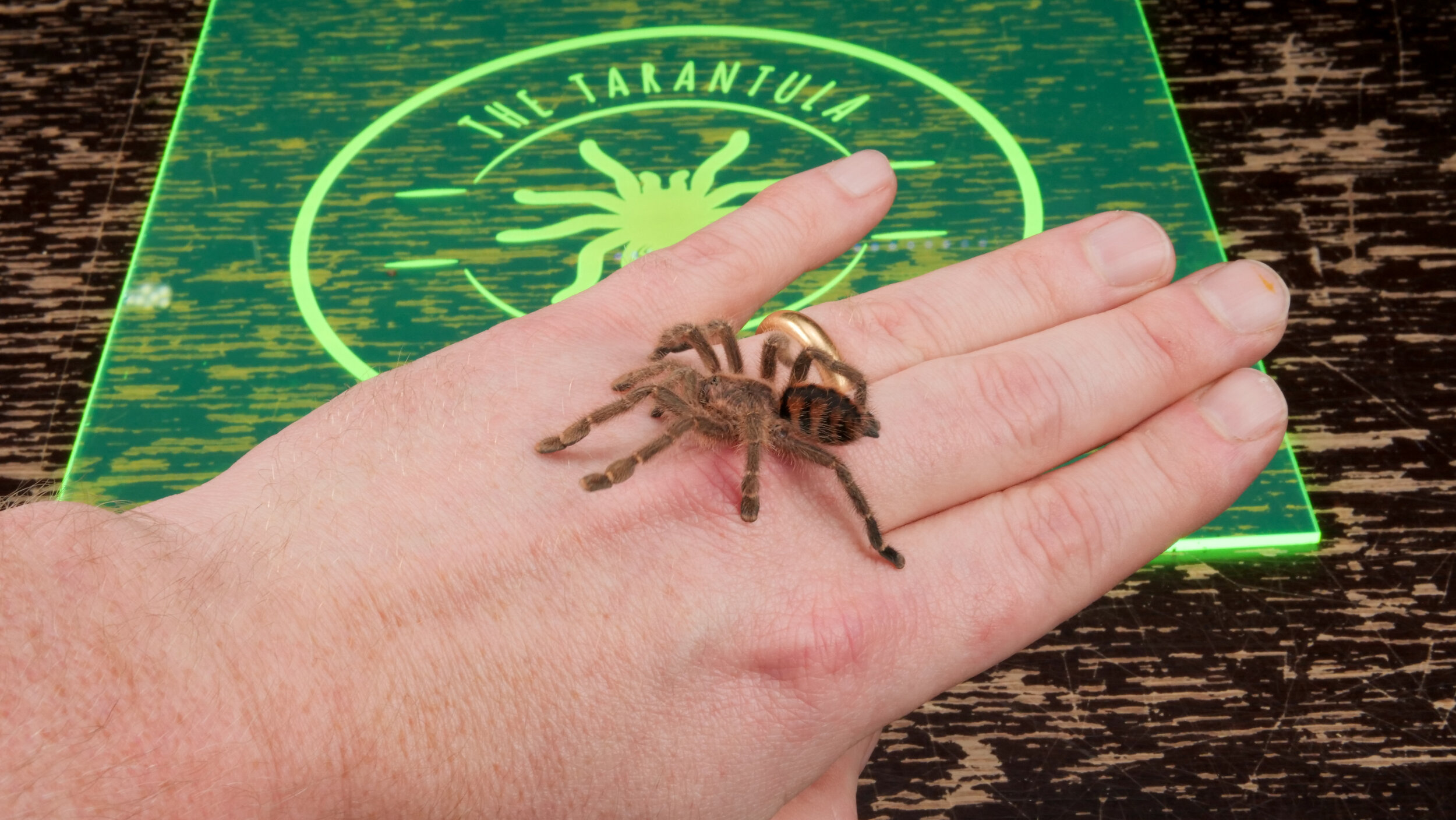Avicularia minatrix (Red Stripe Pinktoe Tarantula)
Care Sheet
Care & Husbandry Video
The Avicularia minatrix, known commonly as the Redstripe Pinktoe, Venezualen Red Stripe and Red Slate Pinktoe Tarantula, is one of my FAVORITE dwarf species! This New World arboreal tarantnula is one of the smallest and most reclusive species in the hobby, except for maybe the T. seladonia. In this video I tell you how I care for and feed my A. minatrix. I cover enclosures, husbandry, feeding schedules, enviroment, temperatures, humidty, and more.
Scientific Name: Avicularia minatrix
Common Name: Red Slate Pink Toe Tarantula
Type: Arboreal
Location: Venezuela
Diagonal Leg Span (DLS): up to 2.5-3in (7cm)
Growth Rate: Medium/Fast
Life Expectancy: Females (10 to 12 years) | Males (2 to 3 years)
Recommended Experience Level: Beginner
Described by Pocock, 1903 The Red Slate Pink Toe, is known scientifically as the Avicularia minatrix, is a NEW WORLD arboreal dwarf tarantula from Venezuela. This is the smallest tarantula in the Avicularia genus, only growing to about 2.5” inches in size. In nature, this species tends to make their homes in the Bromeliads and can be found in the coastal regions of Venezuela as well as the areas near Maracay. In nature, 2 or 3 A. minatrix have been observed sharing on bromeliad making separate web tunnels in different parts of the same plant. Though it seems they tolerate living closely together out of necessity and aren't a true communal species that can be kept together in one enclosure in captivity. This species can be difficult to find available for sale and usually are more expensive than other Avicularia species, making it a VERY risky and costly to attempt to experiment keeping them communally. In fact, it is not something I personally would try or suggest others to do. Part of the reason they can be difficult to come across and expensive to purchase is because they have very few eggs per sac compared to other species of tarantulas. Typically there seems to be as little as 20 eggs per sac and at most maybe 40 eggs. That along with the fact dwarf species don't seem to be as sought after as larger species of tarantulas, there may not be a demand large enough to encourage breeders to constantly attempt to produce large numbers of egg sacs.
Unlike other species of Avicularia, Caribena, or Ybyrapora tarantulas, the minatrix is probably my most reclusive NW arboreal. I see my Psalmopeous species more than I see my minatrix. Mostly she spends her time huddled up in her web tunnels and rarely is out on display or walking around her enclosure. Which is a shame because they are such a beautiful species. Not only is this species shy and reclusive, but they can be very skittish as well. Mine will quickly bolt around its enclosure and dive into hiding if I happen to catch her out and frequently will run away from its prey when I feed her before actually pouncing on it and eating. This isn't a species I would attempt to handle, not because it has powerful venom, in fact it has been theorized, though not yet scientifically proven, that they have some of the weakest venom of any species of tarantula, and not because of the urticating hairs, as Avicularia species only posses Type 2 urticating hairs meaning they don't kick the hairs up in a cloud when they feel threatened like other species of new world tarantulas, the only way Type 2 urticating setae can be transferred is with direct contact. So if your Avicularia is rubbing its abdomen on you, it isn't showing affection, it is trying to rub off itchy hairs on you. But I wouldnt handle this species because it is so small and skittish. My concern is that because it is easily startled, it will attempt to bolt or jump and escape, become hurt, possibly even fatally. So this is a species I keep safely in its enclosure and am cautious when feeding and rehousing.
I keep my A. minatrix slings in large dram vials of small acrylic boxes that are taller than they are wide. Even as spiderlings they don't spend much time on the floor of the enclosure and I have never seen mine attempt to burrow. Even so, I still fill up a ¼- ⅓ of the enclosure with substrate that I keep slightly damp to maintain a little humidity. Much more important than humidity for this species is ventilation. They seem to thrive when given adequate cross ventilation as opposed the ventilation on the top of the enclosure. If making your own enclosures, be sure to not make the ventilation holes too large as this species is very tiny as a sling and can squeeze out of any hole the size of its carapace. I provide a small piece of cork bark placed vertically against the side of the enclosure or some tiny fake plants, anything that can give it plenty of anchor points to make its webbing. These species will typically web up the top of the enclosure extensively, so using an enclosure that opens from the side or bottom will work best so as not to destroy their webbing over and over again when feeding.
Once they outgrow those enclosures, I move them into juvenile arboreal enclosures like these Amac boxes. Again I prefer to turn them upside down so I can open up the enclosure to change the water and drop in prey without disturbing their webbing. I use cross ventilation and provide a large water dish to [provide adequate humidity. I also overflow the water dish a little every week to get a little moisture in the substrate without saturating it. In nature, this species environment is prone to periods of time that are very dry with no rainfall as well as periods when there is extensive rainfall. So they have the ability to survive dry and moist conditions but finding a balance and providing cross ventilation seems much more effective than constantly misting them and stressing out about keeping the enclosure at a specific level of humidity.
For adults, since they are a dwarf species, they do not need a very large enclosure. I prefer to have about 4x the leg span of the tarantula in height for the enclosure. So you don’t need anything taller than 8-12”. So exo terra nano talls, 1 gallon plastic containers, or acrylic arboreal enclosures work very well. I do not recommend the enclosures with an opening lid on the top that also is the sole source of ventilation as all humidity will escape out the top and you will be disturbing their webbing anytime you open up their enclosure. As with most Avicularia and Caribena species, stagnant air is what you want to avoid the most. So providing cross ventilation and a large water dish is all you need to provide adequate humidity and air movement. I do not mist my Avicularia’s enclosures as it seems to only stress them out, stagnate the air, and evaporate within an hour. I have had much more luck just keeping a large water dish full in their enclosure.
When it comes to feeding, I give my spiderlings FFF, Flour beetles, pinhead crickets or roaches, or even cut up pieces of meal worms or large cricket legs. They will scavenge feed at this size, but if I am feeding cut up pieces, I make sure to set them down on their webbing near the entrance to their tunnel when they can easily be found. Since this species rarely goes down to the floor of their enclosure, they may not find prey you drop down on the ground. I feed my spiderlings 1-2x a week depending on their abdomen size. More prey more often when they are thin, less prey less often as their abdomen gets plump and I avoid over feeding them so as not to cause any issues with molting. I wait at least 24 hours after they molt before attempting to feed them again.
For juveniles, I feed them once a week and drop in 2 small-medium crickets again, based on the size of their abdomen. I prefer to feed this species crickets as crickets will jump around and crawl up cork bark while meal worms and roaches tend to stay on the bottom of the enclosure or even burrow into the substrate to hide. I wait 3-5 days after a molt before offering them food to give their fangs plenty of time to harden up.
And for adults, since they are such a small species, they don’t require much food. I usually drop in one large cricket every week or two. I never feed this species any prey larger than ⅔ their size. I may drop in 2 crickets every week or two after a molt when they are thin, but cut back on the amount and frequency as their abdomen gets plump.
This species can go weeks without eating when in premolt, so I do not worry too much when they refuse food. I just take the prey out within 24 hours and try again in a week.
In my opinion, this is one of the coolest species in the Avicularia genus with the cool red stripes on their abdomen, and what i really like about them is that they don’t really change their appearance much as they grow. As spiderlings, they have about the same pattern and coloration as they do when they are full grown which is unique for Avicularia. They also make some very cool web tunnels that can get quite extensive, so if you like heavy webbing tarantulas, these should definitely make your list. This is a very colorful and unique species despite their propensity to hide and I really enjoy having them in my collection.








